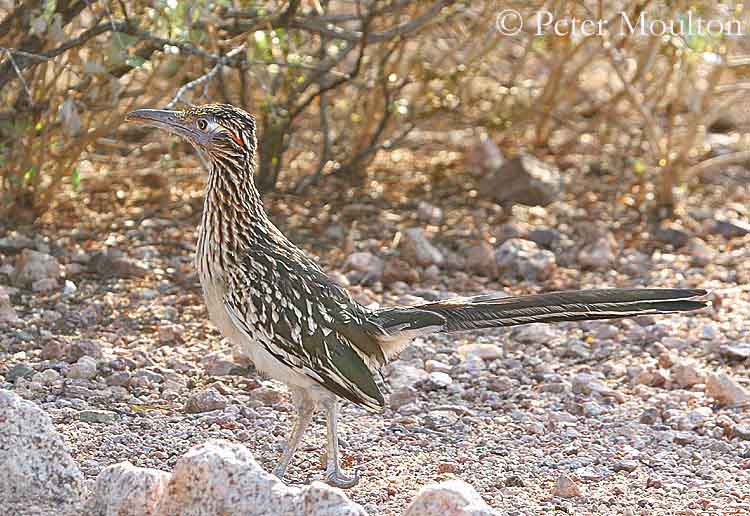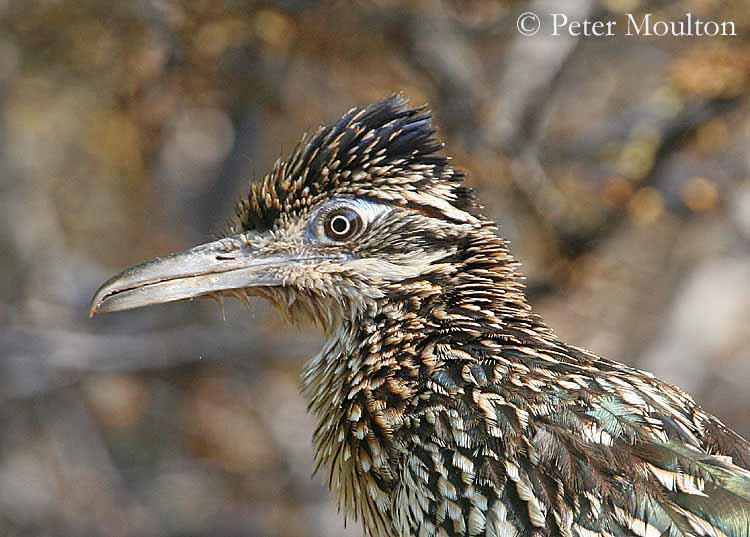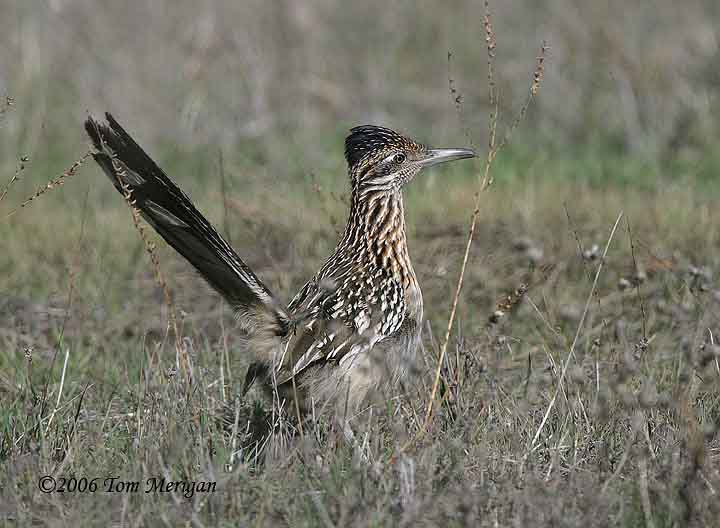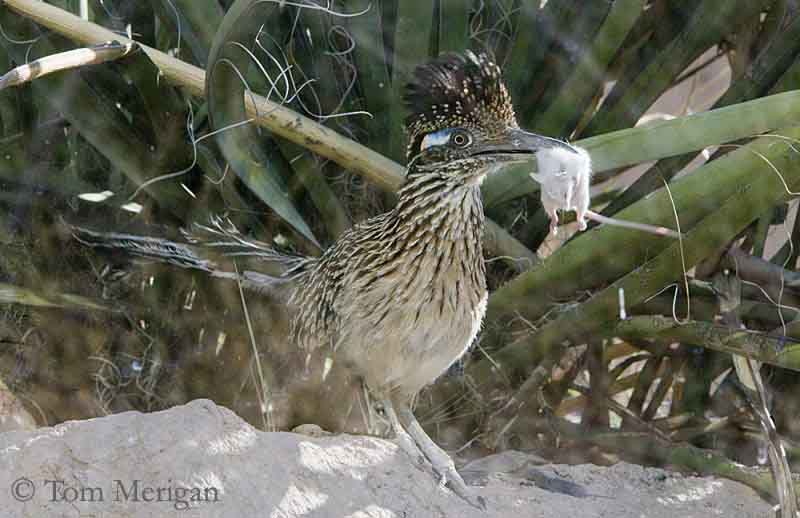
Greater Roadrunner
Geococcyx californianus
Cuculiforme Order – Cuculidae Family
BIOMETRICS:
Length: 52-62 cm; Wingspan: 49-60 cm; Weight: 220-340 g
LONGEVITY: up to 8 years
DESCRIPTION:
Great Roadrunner is a large cuckoo, streaked with brown and white. Breast is mostly white, streaked brown. Belly is dirty brown. Tail is long and white-edged. Wings are short and round, with white crescent on primaries.
It has conspicuous bushy crest. Bill is long, heavy and bluish. Eyes are yellow, and we can see a patch of bare skin with blue and red colours, in the rear eye.
Legs and feet are bluish, and feet are zygodactylous.
Both sexes are similar, male larger than female.
Juvenile lacks post ocular patch, and its colour is more bronze.

VOICE: SOUNDS BY XENO-CANTO
Greater Roadrunner’s song is dovelike, descending in pitch, in series of six slow and low “coos”. To attract female, male gives a whirring call. When it is alarmed, it produces a clackely noise by clicking mandibles in a sharp and rapid manner.
HABITAT:
Greater Roadrunner is common in scrub desert, or areas with scattered bushes for cover, and open grassy areas to forage. It breeds in coastal sage scrub, or chaparral, which presents many types of terrains, flat plains, rocky hills and mountain slopes, and with very hot and dry weather.
RANGE:
Greater Roadrunner is resident from central and southern California, eastwards to south-western Missouri and western Louisiana, and southwards into central Mexico.
BEHAVIOUR:
Greater Roadrunner forages on the ground, catching preys with its bill; it may beat a large prey against a hard surface to kill it before to eat. It walks quickly to hunt, searching for prey, and then, dashing forwards to catch it. It may jump into the air to catch some flying insects. To kill small rodents, it smashes the prey’s body and head against a rock, and swallows it whole. When it catches a rattlesnake, it picks it up by the tail and kills it by beating the head to the ground. This bird is a famous snake killer, darting in to stab the head of its prey. Some Cowboy tales are speaking of Greater Roadrunner building a fence with cactus pieces around the snake to trap and kill it.

When it is alarmed, it slowly raises its crest and its long tail, and utters a series of “coos”, or clatters its beak. Pairs are non migratory, and defend territories all year round.
Greater Roadrunner is known for its curiosity, and it will not hesitate to approach humans.
During the breeding season, male performs courtship displays, including chasing female, with frequent rests; courtship feeding, with male offering food to female; another display shows male wagging its tail in front of female, bowing and giving cooing sounds. Then, it jumps into the air. They mate for life.
FLIGHT:
Greater Roadrunner certainly can fly, but normally does not, or only for short distances, or under duress. It may flap its wings to run quickly.
REPRODUCTION:
Breeding and nesting seasons vary, according to rainy seasons including more food resources. Greater Roadrunner is solitary nester.
Its nest is situated not far above the ground, in bush, cactus or small tree. The male searches for materials while the female builds the flat nest. It is made with sticks, grass, feathers, and sometimes we can find snakeskin and cow manure.
Female lays 3 to 6 ivory-coloured eggs. Incubation lasts about 20 days, by both parents, male more than female. Chicks hatch with closed eyes but active and able to beg food. They are fed by both adults. They fledge at about 18 to 21 days, but parents feed them for up to 30 to 40 days more.
Young reach sexual maturity at about 2 to 3 years of age.
Greater Roadrunner may parasite other nest’s species, such as Common Raven and Northern Mockingbird. This species produces one or two clutches per year, according to rainy seasons.
Fr: Grand Géocoucou
All : Wegekuckuck
Esp : Correcaminos Grande
Ital : Corridore della strada
Nd : Roadrunner
Sd : Större tuppgök
Photographs by Pete Moulton
His website : Pete Moulton Photography
Photographs by Tom Merigan
His website :
Tom Meriganís Photo Galleries
Text by Nicole Bouglouan
Sources :
FIELD GUIDE TO THE BIRDS OF NORTH AMERICA - National Geographic Society - ISBN: 0792274512
All About Birds (Cornell Lab of Ornithology)
Animal Diversity Web (University of Michigan Museum of Zoology)
What Bird-The ultimate Bird Guide (Mitchell Waite)
Wikipedia (Wikipedia, The Free Encyclopedia)
DIET:
Greater Roadrunner is omnivorous, eating large insects, lizards, snakes, mice, scorpions and tarantulas. It also eats fruits and seeds.
It is a potential predator of quails, sparrows and hummingbirds.
PROTECTION / THREATS / STATUS:
Greater Roadrunner is threatened by habitat loss and urban developments. They may be illegally shot, and they are vulnerable to pesticides.
They are widespread in Southwest United States and Mexico.

